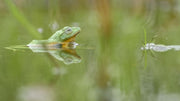
A late-summer evening, your patio lights flick on, and two hefty amphibians pop their eyes above the pond rim. One lets out a quick gunk—the other follows with a window-shaking jug-o-rum. Which is the native green frog and which is the voracious American bullfrog? Knowing the answer matters: bullfrogs can swallow songbirds and wipe out smaller frog species, while green frogs usually settle for insects and play a quieter role in the backyard food web. This guide unpacks the green frog vs bullfrog puzzle, from quick field marks to smart pond tweaks that let you observe (or manage) both without unsettling the ecosystem.
Why It Matters to Know Your Frogs
- Biodiversity check-up – Spotting native green frogs (Lithobates clamitans) tells you water quality is on point; a pond ruled by bullfrogs (Lithobates catesbeianus) often hints at nutrient overload and missing predators.
- Sound & serenity – Bullfrogs call all night, vibrating windowpanes; green frogs “plunk” like a loose banjo string and stop.
- Balance vs. takeover – Bullfrogs grow larger, breed longer, and consume anything that fits in their mouth—including juvenile turtles and ducklings. Deciding when to encourage or control them starts with proper ID.
Fast Comparison: Bullfrog vs. Green Frog (in plain text)

- Size – Adult green frogs measure about 2.5–4 inches (6–10 cm) from snout to vent, whereas American bullfrogs commonly reach 3.5–6 inches (9–15 cm) and feel noticeably heavier in hand.
- Back ridges (dorsolateral folds) – On a green frog, two straight ridges run from each eye halfway down the body; on a bullfrog those ridges curve around the ear disc and fade out, giving the back a smoother look.
- Call – Green frogs make a short, twangy “gunk” or “plunk.” Bullfrogs boom a deep, resonant “jug-o-rum” that can carry across a lake.
- Ear vs. eye – In green frogs the tympanum (circular ear) is roughly the same diameter as the eye; on male bullfrogs the tympanum is much larger than the eye.
- Leg test – Fold a hind leg forward: if the heel stops shy of the snout tip you likely have a green frog; if it extends well past the snout, you’re holding a bullfrog.
- Native range – Both species are native to the eastern United States, but bullfrogs have invaded west of the Rockies where they often outcompete local amphibians.
(Tip: use a phone flashlight or a low-glare Poposoap RGB Pond Light to inspect folds and ear discs without blinding the frogs.)
Appearance & Anatomy Differences

Body build. Green frogs look athletic yet modest; bullfrogs appear burlier with broader heads. Green frogs show a yellow throat in mature males and often sport bronze or brown mottling. Bullfrogs trend olive-green to dark brown, sometimes nearly black in shaded ponds.
Back ridges. The dorsolateral fold is the quickest ID marker: straight and obvious on a green frog, it loops around the bullfrog’s eardrum before fading.
Leg stretch test. Gently coax a frog onto a flat rock. Fold its hind leg forward: if the heel passes the nose, you’re likely handling a bullfrog.
Behavior & Sound
Bullfrogs reign as ambush predators, floating motionless until a dragonfly, small fish—or another frog—drifts close enough. Green frogs sit nearer shorelines and prefer insects. Both species call at dusk; to document them without disturbing the scene, add Poposoap Warm-White Solar Pond Lights (three brightness modes) aimed away from the water’s surface. Their low-color-temperature glow lets a smartphone mic capture calls clearly without spooking amphibians.
Ecological Roles & Risks in Your Pond
- Green frogs eat mosquitoes, midges, and slugs—excellent natural pest control.
- Bullfrogs serve as top predators but can eliminate smaller native frogs, dwarf fish, and even baby painted turtles.
Robust filtration keeps prey items abundant for green frogs yet discourages nutrient spikes that favor bullfrog tadpoles. A Poposoap 20W Solar Pond Filter (280 GPH) traps excess fish food and leaf debris, holding ammonia down and clarity up while operating off-grid.
Should You Encourage or Control Bullfrogs?

Encourage them if you maintain a large, balanced ecosystem (>1 000 gallons) with healthy forage fish and you enjoy their booming chorus.
Control them if you keep delicate species—chorus frogs, ornamental goldfish fry, or small turtles—at risk of becoming lunch. Humane control means nightly hand-netting adults, removing dinner-plate-sized tadpoles with a seine net, or skimming floating egg masses soon after spawning.
How to Create a Frog-Friendly, Balanced Pond

- Provide micro-habitats. Stack flat rocks for sunning; leave shaded root tangles for green-frog retreats.
- Aerate gently. A Poposoap Solar Fountain P110L (120 GPH) circulates surface water without turning it into whitewater—oxygen for fish, stillness for tadpoles.
- Maintain clarity. Combine filtration with emergent plants (pickerelweed, sweet flag) to out-compete algae and offer hiding spots for metamorphs.
- Night-safe lighting. Use dimmable Poposoap LEDs aimed away from nesting banks; frogs rely on darkness to avoid raccoons and herons.
- Skip pesticides. Amphibian skin absorbs chemicals; a balanced bug population is healthier (and cheaper) than broadcast spraying.
Conclusion: Coexisting with Amphibians
Sorting American bullfrog vs green frog comes down to ridges, calls, and size. Once you know who’s who, you can fine-tune pond design: invite native green frogs as mosquito patrol, rein in bullfrogs when their appetite threatens biodiversity, and keep the whole system healthy with quiet solar gear from Poposoap. The payoff is a living chorus at dusk, crystal water by day, and a front-row seat to nature’s drama—no tickets required.










